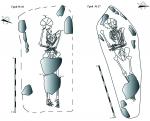Summary (English)
ARCHAEOLOGICAL EXPLORATIONS IN VRATSA (Alexandra Petrova – aleksandrapp@abv.bg, Nartsis Torbov, Georgi Ganetsovski) Thirty-nine Christian graves were discovered, containing the remains of 40 individuals; 38 of the burials dated from the end of the 11th to 14th centuries. The burial pits were partly or completely surrounded with uneven stones. The skeletal remains from an earlier burial were reburied in Grave No. 37. Two women were buried in Graves Nos. 10 and 27 and in each grave two large uneven stones were placed over the legs of the bodies. In addition, both graves contained a significant number of jewelry, mostly bracelets. Grave goods were discovered in many of the graves, consisting of jewelry, decorations of the clothes and coins. The personal ornaments were produced from copper alloy (some of them silvered), iron, glass and Cypraea cowries. The latest burial in the cemetery that was clearly dated was grave No. 22; it contained a coin of the Bulgarian King Ivan Alexander and his son Michael Asen IV. The cemetery belonged to the citizens of the Mediaeval town of Vratitsa. Grave No. 16 was a pit of the Ottoman period that contained a body in a folded position.
- Alexandra Petrova - Museum of History – Vratsa
- Nartsis Torbov - Museum of History – Vratsa
- Georgi Ganetsovski - Museum of History – Vratsa
Director
Team
Research Body
- Museum of History – Vratsa






![Download [PDF]](/excavation/skins/fasti/images/results/download_sml.png)
